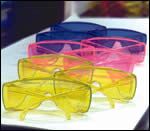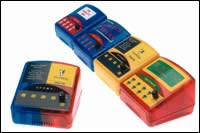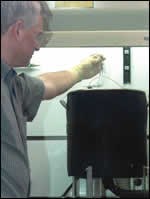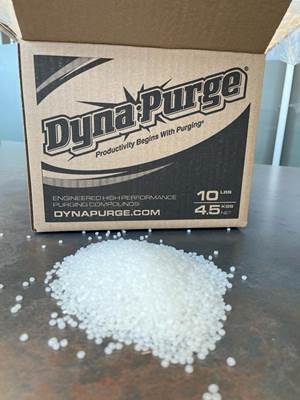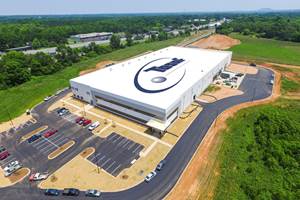Color-Infusion Process Is Suited to Short Runs of Different Hues
Bayer Plastics in Pittsburgh is commercializing its new Aura dip-dyeing process for molded parts, sheets, or profiles of engineering thermoplastics.
Bayer Plastics in Pittsburgh is commercializing its new Aura dip-dyeing process for molded parts, sheets, or profiles of engineering thermoplastics. The process, which was presented at the NPE show last month, involves immersing parts made of polycarbonate, ABS, or PC/ABS in a heated bath of an aqueous dispersion of liquid dyes and polymer-friendly surfactants. The formulation permits colorant to penetrate 0.005 to 0.01 in. into the part surface in a manner reminiscent of coloring Easter eggs.
“This opens up useful new ways to differentiate parts by color,” says Mark Witman, director of Bayer’s Plastics Injection Molding Technical Center. Dipping is now done manually by a batch method, employing a 32-liter hot bath supplied by Bayer’s Hennecke Ma chinery subsidiary in Pittsburgh.
Bayer initially thought color infusion would be best suited to niche applications where volumes are modest and the color range is extensive. The process is being used to color portable audio devices and toys and is in testing for furniture parts, consumer products (safety glasses), sporting goods (golf balls), light shades, and CDs.
“Now our goal is to industrialize color infusion,” says Witman, noting that a 54-liter hot bath has already been designed by Hennecke to permit the coloring of larger parts. The longer-term intent is to broaden Aura into a continuous, in-line process that would be effective in higher-volume color programs.
Far-reaching potential
In the Aura process, dipping is done at a controlled temperature and for a specific time ranging from seconds to more than a minute. Immersion time is determined by the end use, the intensity of color desired, and the depth of infusion into part surfaces required. Color is infused into parts at sufficient depth to make it permanent and resistant to scratching. Parts to be treated can be clear, translucent, or opaque—even black. The Aura color palette consists of reds, blues, purples, greens, yellows, and more, and Bayer plans to extend the range as the market demands.
“Aura gives customers ultimate color control,” declares Robert Pyles, a Bayer industry manager and inventor of the color-infusion process. He explains that users are able to mix and match dyes to achieve subtle effects at relatively low cost. Color can be made more or less intense by lengthening or shortening the immersion time. A sequence of dips using primary colors can be employed to create a secondary color. It is also possible to make multi-colored parts by using masking techniques together with a sequence of dipping steps in different colors.
Bayer officials say color infusion brings economic benefits, especially when deployed in relatively small-scale operations. One reason is that the process can eliminate the need for an inventory of precolored compounds. Color infusion also allows any number of parts of any color to be made on demand, minimizing part inventory and waste resulting from production of excess parts in any color.
Color infusion can be applied to finished parts after they are molded, or to sheets or profiles prior to thermoforming or fabrication. Metallic or other special pigment effects or in-mold decorative appliques applied to parts are not adversely affected by subsequent color infusion, Bayer says.
Company officials say color infusion is user-friendly. After immersion, parts are simply rinsed and dried. Colors used in the hot bath can be changed easily and quickly. Bayer describes its process as environmentally benign, though the colors used in the process are not FDA-approved for food-contact or medical uses.
Witman says the Aura process is still in development, and he declines to provide detailed information on equipment and colorant costs at this time. A strategy for licensing the process will be announced shortly.
Related Content
Reduce Downtime and Scrap in the Blown Film Industry
The blown film sector now benefits from a tailored solution developed by Chem-Trend to preserve integrity of the bubble.
Read MoreRiverdale Global Showing Latest Innovations and New Satellite Location in Wisconsin
NPE2024: Live demos of updated RGS controller are among the highlights at its Wisconsin facility that will house the ‘new’ color R&D lab.
Read More'Dual Action' Purging Compound Accelerates Color Changes
NPE2024: Shuman Plastics’ Dyna-Purge Division launches Dyna-Purge L, extending its “3X technology.”
Read MoreTosaf’s Investments in North America Result in 40% Increase in Production Capacity
Backed by a global presence, Tosaf provides localized additive and color solutions, and services for the plastic industry in North America.
Read MoreRead Next
See Recyclers Close the Loop on Trade Show Production Scrap at NPE2024
A collaboration between show organizer PLASTICS, recycler CPR and size reduction experts WEIMA and Conair recovered and recycled all production scrap at NPE2024.
Read MoreLead the Conversation, Change the Conversation
Coverage of single-use plastics can be both misleading and demoralizing. Here are 10 tips for changing the perception of the plastics industry at your company and in your community.
Read MorePeople 4.0 – How to Get Buy-In from Your Staff for Industry 4.0 Systems
Implementing a production monitoring system as the foundation of a ‘smart factory’ is about integrating people with new technology as much as it is about integrating machines and computers. Here are tips from a company that has gone through the process.
Read More



